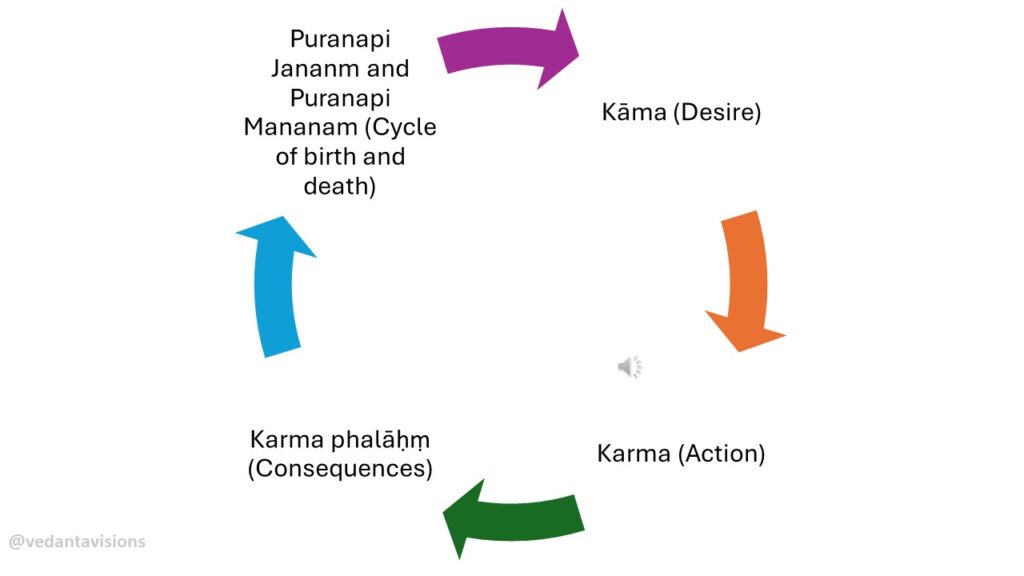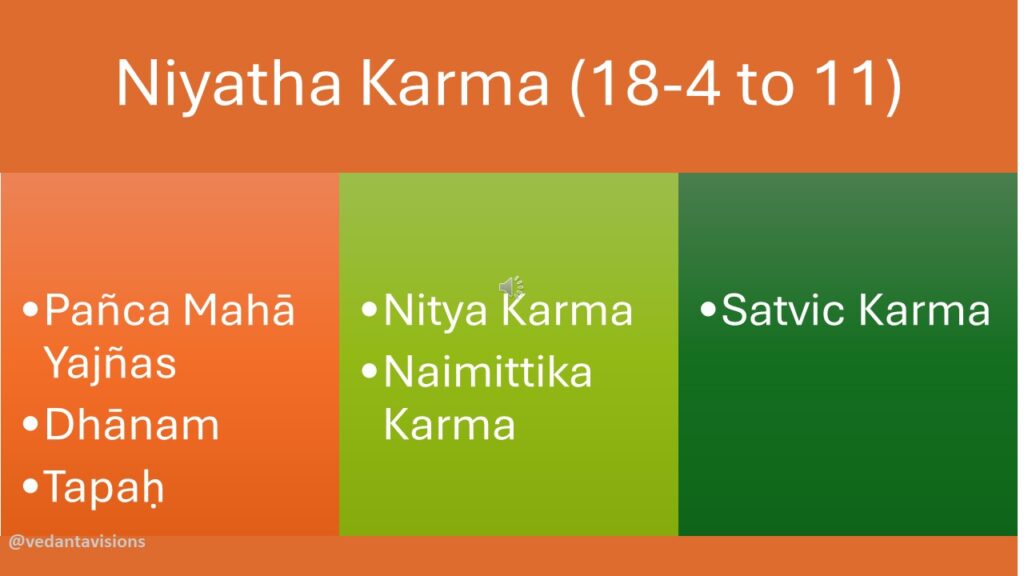Bhagwat Geeta, Class 185 – Chapter 14 Verses 10 to 19
When sattva guṇa is dominant jñānendryas will be more operational, whereas rājo guṇa is dominant, karmēndriyas will be more functional; whereas when tāmo guṇa is dominant, neither jñānendryas nor karmēndriyas will be operational. Tamo guna will suppress jñānendrya and make them dull. Tamo guna will also suppress karmēndriyas also and there will be no activities. A tamasic person should not go to vedanta vichAra, but start with sakama karma, then to niṣkāma karma, progress to Upasana and then only to vedanta.
The fourth topic is gathi or what direction each of dominant personalities will travel.
Verse 14
If a person dies when sattva is predominant, then, he attains those pure worlds belonging to the upsAakas of great deities.
If a sattva guna pradhāna ajñāni dies, he will go to higher and purer loka or punya predominant loka. When a jñāni dies, his bodies merge with prabañcha and a jñāni does not travel after death.
Verse 15
Having died when Rajas is predominant, one is born amidst those who are attached to action. Likewise, having died when tamas is predominant, one is born in the wombs of deluded being.
A rājo guna dominant person will be reborn in a loka in which people are given lot of karma, that is manuṣhya loka. In the higher lokas and lower lokas you can’t acquire new karma phalāḥṃ you can only exhaust karma phalāḥṃ. Only in manuṣya loka, a person can both acquire and exhaust karma phalāḥṃ.
When a tāmo guna predominant person dies, that person is reborn in lower planes of existence. It can be lower lokas or they will be born as animals or plants where they will have no free will to acquire fresh karma.
Verse 16
Scriptures say that the result of sattvic action is pure punya. The result of rajasic action is sorrow. Whereas the result of tamasic action is ignorance.
These verses discuss phalāḥṃ of each guna. Sattvic person’s actions are free from anxiety, tension and there will be harmony and peace. There will be spiritual growth.
For a person is rajasic, there will be lot of activities, anxiety, tension, intolerance, stress and strain. There will be hurtful chain reaction among rajasic personalities. Even communication may breakdown after a while, and it will be a broken environment. There will be materialistic prosperity without spiritual growth and peace.
For a tamasic person, human life is wasted, and ignorance is perpetuated. Ajñānam or ignorance is the result of tamasic karma.
Verse 17
Knowledge is born out of sattva. Greed is born out of rajas. Negligence and delusion along with ignorance are born out of tamas.
Out of sattva guna jñāna is born, because jñānendryas are bright and operational. Knowledge increases by leaps and bounds.
When rājo guna is dominant there will be greed and ambition. Tāmo guna will result in forgetfulness, omission delusion conflict and indecisiveness. Perpetuation of ignorance will continue for a tamasic person..
Verse 18
Sattvic people go up. Rajasic people remain in the middle. Tamasic people, abiding by the functions of the lowest guna go down.
Sattva guna predominant person goes to higher loka. Rājo guna predominant person neither goes up nor goes down, and they stay stagnant. Tamo guna predominant person travel downward. Higher, middle and lower lokas refer to the quality of the lokas and not the physical location.
Verse 19
When the seer understands the doer to be none other than the gunas and knows the self which is beyond the gunas, he attains My nature
There is no escape from the bondage created by the three gunas; only the mode of bondage will be different. Sattva guna is addicted to knowledge predominant environment. A rājasa guna is addicted to activity predominant environment. AhaMkAra can never be free from gunas. It can only change the predominance of the gunas. The only way is to claim the higher nature of I, the sAkshi chaithanyam. SAkshi need not become guna free, because it never has any guna. So, there is no question of how to become guna free. You become guna free when you shift your identification from the lower I, the ego, ahaMkAra, anatma to higher I, consciousness, sAkshi chaithanyam, Atma. As long as I identify myself with body mind complex, I will be saguna ahaMkAra and I can never escape from saMsAra. The only solution is to know and identify with the higher nature and own up the higher nature.







